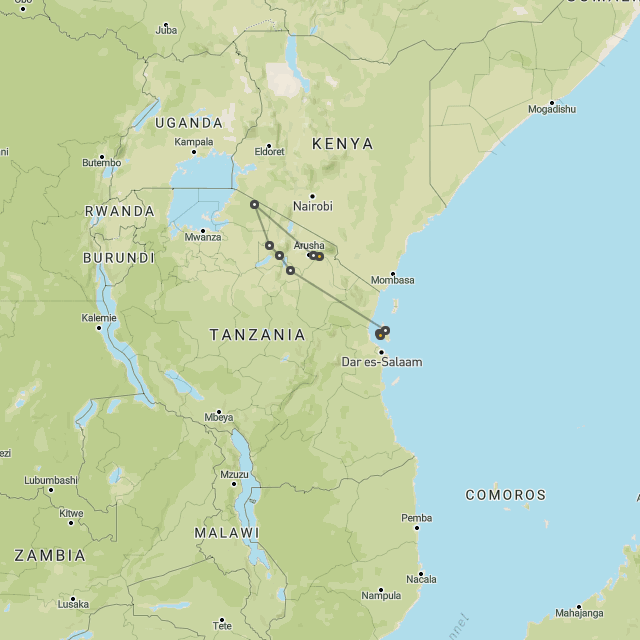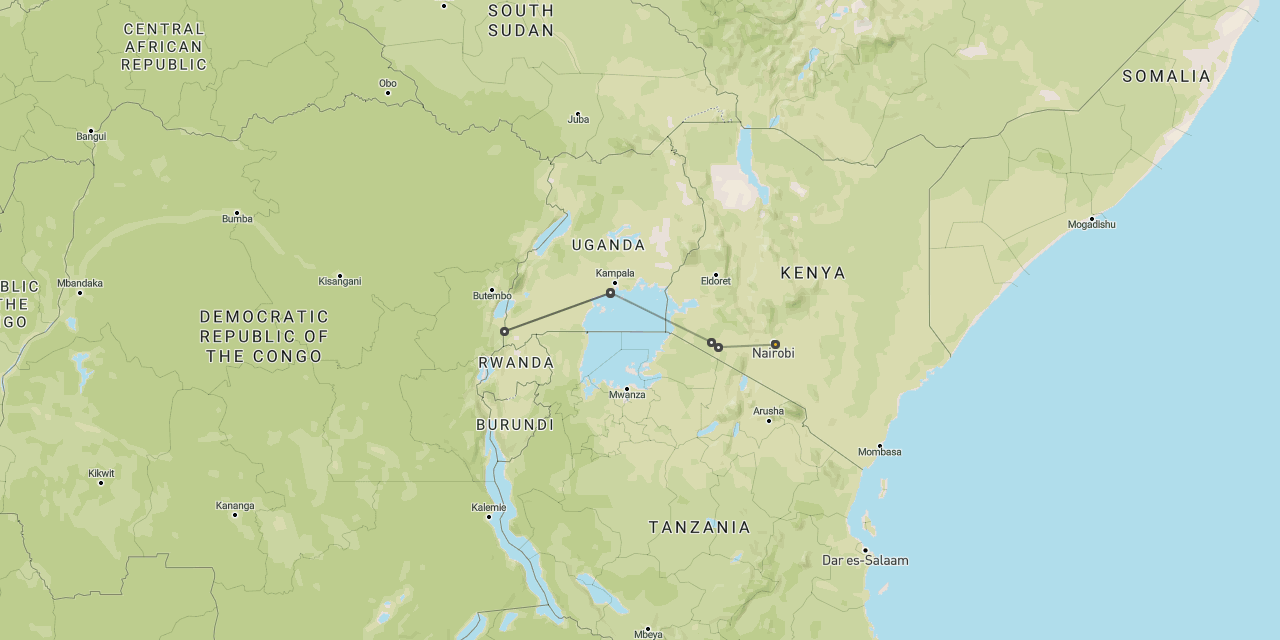
Cheetah safaris
Cheetahs
may be the fastest of the predators,
but they’re not the brightest

under pressure from other predators and humans
Cheetahs are the third largest cats in Africa after lions and leopards.
They are by far the fastest land mammals in the world, capable of accelerating from zero to 100 kph or 62 mph in less than three seconds and with a maximum speed of 120 kph or 75 mph over short distances.
But the cost of such specialisation is very high. They have relatively small brains, they are ill-equipped to defend themselves against other predators, are very susceptible to injury and their ranges are limited to large areas of open savanna.
Of the three main feline predators in Africa, it’s cheetahs who are under the greatest threat.
A key problem is that cheetahs are unable to defend their catches from other predators, nor are they able to drag them up a tree like leopards do. Instead they are obliged to hunt, kill and then eat as fast as they can before the scavengers arrive on the scene.
Predator-rich environments are therefore not so good for cheetahs, meaning that they are noticeably deficient in many of Africa’s finest wildlife areas.
On top of these natural limitations, cheetahs are also subject to the usual human pressures, including loss of habitat, conflict with domestic herding, spread of disease from domestic animals and poaching.
A lot of good conservation work is being carried out around cheetahs and their populations, although small, are relatively stable or increasing in many areas.
let us know about your specific interests
and we will help build an amazing safari

What are the best locations for cheetah viewing?
Serengeti is easily the best location for wild cheetahs
Cheetahs may be relatively rare in the wild, but can still be found quite reliably in a good range of locations.
In Tanzania, the Serengeti is the best location for viewing wild cheetahs in the world, especially on the southern plains during the Dec-May green season and in central areas during the Jun-Nov dry season. The cheetah viewing in these areas can be comically good, last time we tried to break our record we saw more than twenty different cats in a single day! There are also cheetahs in other areas, notably Selous, Ruaha and Katavi, although the numbers are low and sightings are much less reliable.
In Kenya, the best location for cheetahs is undoubtedly the Maasai Mara, where they have become so habituated to vehicles that they often climb aboard to use them as lookouts (although this is illegal and not to be encouraged). Cheetahs are also present in Amboseli and Tsavo West, although the population densities are much lower and sightings are far less reliable.
In Zambia, there are cheetahs in both South Luangwa and Kafue, but sightings are unreliable. There are also a few cheetahs in the lesser visited Liuwa Plains. In fact this might even be the most reliable area due to the open terrain, despite the small population. There are no cheetahs in the prestigious Lower Zambezi National Park.
In Botswana, the Okavango Delta and Linyanti Waterfront areas also have small populations of cheetahs, although their numbers are severely restricted by the rich diversity of other predators. Perhaps the single most reliable area is around Kwara Camp and Splash Camp but we have also had some good sightings around Mokolwane Camp, Lebala Camp, Selinda Camp and Zarafa Camp. We’ve seen cheetahs in lots of other areas, but not with any real regularity. On the other hand, the Central Kalahari area is much more of a hotspot, especially in the Deception Valley area accessible from Kalahari Plains Camp. But the inability to drive off road can make sightings really frustrating.
In South Africa, the central portion of Kruger and some of the private reserves to the west offer a reasonable chance of cheetahs. Apparently cheetahs are more reliably to be found in the remote Kgalagadi South reserve to the northwest of the country, but this area isn’t somewhere we tend to include in trips very often.
In Namibia, the central plains used to be a real heartland for cheetahs, but throughout the 1900s they were relentlessly persecuted by farmers and shot as vermin. Incredibly this situation persists in some areas, despite the efforts of various conservation and education projects. The best chances of sighting wild cheetahs these days are in the Halali area of Etosha National Park, although it feels a little bit tame around there. We usually prefer to take our chances in the wilder parts of Damaraland North, where sightings are vaguely possible.

What are the best cheetah projects in Africa?
serious rescue, rehabilitation and release
Cheetah projects are various facilities and locations which have been set up to help protect this highly endangered big cat from extinction.
Most commonly the main work for these projects is taking in orphaned kittens after farmers have poisoned their mothers. The best projects have a proven track record of successfully releasing these cubs back into the wild once they have learned to fend for themselves.
There is also a lot of good work done in educating local people to work with their cheetah populations rather than treating them as vermin.
It is worth noting that there are also disreputable places which keep captive cheetahs and other cute creatures simply as an underhand method of luring in business, without any intention for release or even, in some cases, any great concern about the welfare of the animals. We urge you to avoid such places.
The Africat Foundation
The best known cheetah project is Africat in northcentral Namibia, a long-established project which is primarily involved in taking in cheetahs which have been shot or trapped on farms, rehabilitating them and working towards their re-release into the wild. The place has been featured in various television documentaries.
The project operates on a very extensive private reserve and has some high quality accommodation. Activities include tracking radio-collared cheetahs and the project also caters for leopards, hyenas and wild dogs.
Accommodation is at a handful of properties, including Okonjima Plains Camp.
Cheetah Conservation Fund
Also in the northcentral area of Namibia is Cheetah Conservation Fund (CCF), the most prestigious cheetah project, which concentrates more on the research and education side. It is attempting to look after cheetahs around the world and has been involved in translocation and repopulation projects in Asia as well as Africa.
This project can and really should be visited, although it is much less well geared up for overnight visitors, with relatively simple accommodation options at Cheetah View Lodge.
Serengeti Cheetah Project
The Serengeti Cheetah Project was established in Tanzania back in 1991 and seeks to monitor and protect the small but significant population of cats in this important area.
Although the project has no accommodation or visitor facilities, certain camps in the area provide opportunities to meet with researchers and learn more about their work.
Moholoholo
In the Kruger area of South Africa, the Moholoholo Rescue and Rehabilitation Project also works with cheetahs, albeit on a much smaller scale, with reasonable accommodation at Moholoholo Forest Camp.

Extraordinary tailor-made adventures,
from earthy and edgy to easy and extravagant
From around USD 2500 per person, you set the ceiling
Sample Trips
Here are some of our popular trip shapes

Get started on your trip
It’s never too soon to get in touch, we are here to help with every stage of your planning.
Where Next?
Where Next?
We offer trips to dozens of fabulous countries.
Might one of these might be your next great adventure?

Please rotate your screen.




